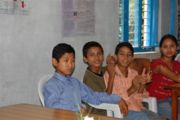User:Wikirandy/demo
Contents
- 1 Lessons learned from Hamro Pathsala (Our Classroom): Ten success factors for using community radio for open and distance learning
- 1.1 1. Design smart from the outset
- 1.2 2. Long-term, learner-centred approach
- 1.3 3. Community course team
- 1.4 4. Commitment by radio management
- 1.5 5. Local resources, voluntary contributions, participation
- 1.6 6. Measurable results
- 1.7 7. Continuous capacity building
- 1.8 8. Networking with schools, other education groups and media
- 1.9 9. Public and community support for education programmes
- 1.10 10. Coordination and cooperation with other initiatives
Lessons learned from Hamro Pathsala (Our Classroom): Ten success factors for using community radio for open and distance learning
1. Design smart from the outset
The initial development workshop
- Must be action oriented and seed a process
- Identify a critical community need
- Mobilise local resources
- Develop a practical, strategic plan
- Have a show on the air within weeks
2. Long-term, learner-centred approach
- The programme plan should build gradually and logically over months and years
- Learner and community needs must be the central focus; changing realities is the guiding objective
- Local needs define which subjects and levels are “taught”
3. Community course team
The programme needs to bring together subject experts, e.g. teachers, and radio producers into a course team that harnesses the skills and experience of both groups
4. Commitment by radio management
Radio management must demonstrate real commitment to
- act immediately on the outputs of the initial design workshop, making appropriate airtime and staff available
- invest in the programme to build social capital and community support
- stay with the process for three to five years
5. Local resources, voluntary contributions, participation
- The programme is most sustainable when run on local resources
- Resource people can also make important voluntary contributions; the radio can cover some costs
- A programme that addresses real needs with integrity will build popular support and goodwill, which in turn encourages community investment
- The entire community – from youth to parents, teachers and extension officers, community leaders and local government authorities – should participate in some capacity
6. Measurable results
The impact of the programme needs to be measured in concrete ways, e.g. the degree of participation or improvement in exam results. Ideally, each programme has a built-in assessment system, e.g. a test questionnaire.
7. Continuous capacity building
Educational use of local media requires teachers and radio staff to work together to create innovative new programmes; good strategies to develop capacity include
- Regular training to build practical teaching and radio skills
- Peer support mechanisms among teachers and radio volunteers
- Mentoring by local and national groups
- Regular workshops to improve programming, forge new partnerships, design new systems
8. Networking with schools, other education groups and media
Radio is more powerful as an education medium in combination with face-to-face classroom learning, print and other media:
- Linkages between in-class and on-air formats, greater integration with overall learning objectives should be encouraged
- Radio programmes offer valuable support both in the classroom and for self-learning
- Learning centres, listeners’ groups and other community networks are invaluable partners
- Competitions and awards attract participation
9. Public and community support for education programmes
Community radio programmes are remarkably cost effective, especially given their impact; however they do require a degree of financial support:
- Public policy should require local authorities responsible for education to provide financial support to community education programmes and recognise in tangible terms the contribution of community radio to local technical and vocational education and life skills
- Community radios need to make a stronger case to listeners, parents, community members and businesses alike to recognise the radio’s contribution to public education and underwrite its investment with direct financial and in-kind support
10. Coordination and cooperation with other initiatives
- Educational programme content helps builds new teaching skills and knowledge among local educators
- Telecentres make good partners for research and providing access to online resources, additional production facilities, and distribution channels
- Partnership with local school boards and district teachers associations eases the burden for individual teachers
- Multi-stakeholder initiatives benefit from representative community boards or councils for consultative decision-making

